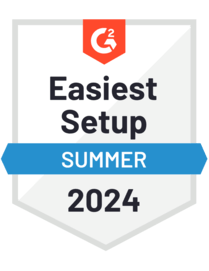MemberPress member Profiles transform basic member accounts into personalized showcases that bring your membership community to life. MemberPress Profiles come with premade, customizable layouts and dynamic content blocks.
This document shows you how to create MembePress Profiles and use them to build your communities.
Understanding Member Profiles
MemberPress ClubSuite™ is a member networking and community pack that includes the ClubDirectory™ and ClubCircles™ Complementos.
Member Profiles are a feature within the ClubDirectory™ add-on, together with Member Directories. To use them on your website, you need to install the MemberPress ClubDirectory™ add-on and configure the global Profile settings.
Member Profiles serve as individual member showcases within your community ecosystem. Each profile provides a dedicated space where members share information, connect with others, and demonstrate their involvement. Profiles automatically generate unique URLs for each member, making them easy to share and discover.
The profile system respects your membership hierarchy and access controls. You can configure different visibility levels, ensuring that members only see the information relevant to their membership level. This granular control maintains privacy while encouraging engagement.
Well-designed profiles encourage members to complete their information and actively participate. You can use the premade MemberPress profile patterns or create your designs with profile-specific Gutenberg blocks.
Creating Profiles
Profiles serve as master templates that define how member profiles appear and function. They determine visual styling, available features, information fields, and interaction capabilities.
Thus, each profile includes layout design, available fields, display sections, and styling options.
You can create different Profiles for different membership levels, with premium members receiving enhanced features. When users qualify for multiple Profiles, MemberPress will display the Profile with the highest priority number. This setup enables you to add features to users’ profiles based on their membership level. For example, if a member upgrades to a higher membership level, their profile type automatically switches, instantly granting enhanced features.
MemberPress will automatically create the default Perfil called “Perfil do usuário”, which will be applied to all users. You can use this default profile type as is, modify it to your needs, or add additional custom ones.
Para create an additional custom ProfileSiga estas etapas:
- Navegue até Dashboard > ClubSuite™ > Profiles.
- Clique em Adicionar novo.
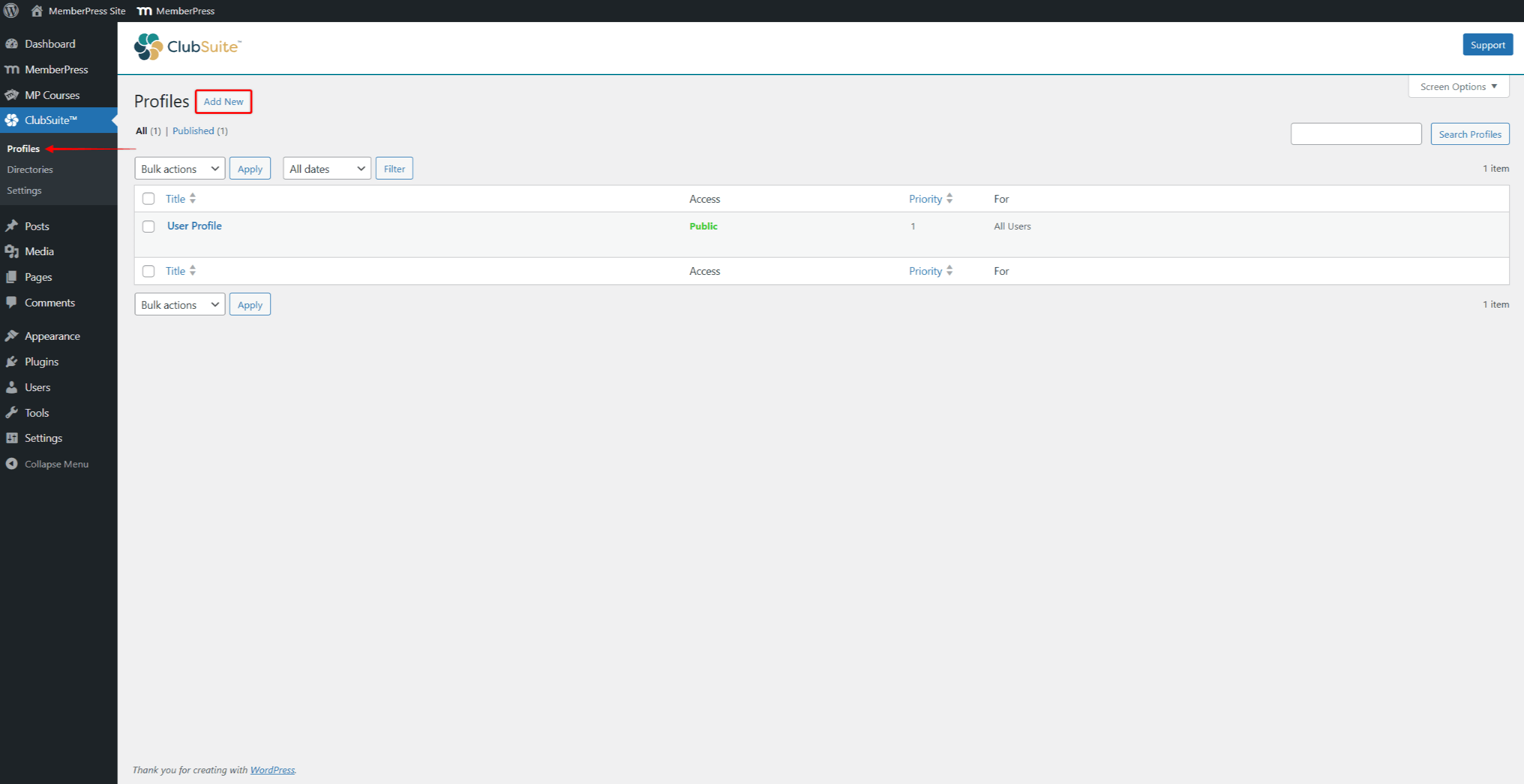
- Choose one of the available premade patterns (Starter Patterns), or close the pattern selection window (X icon) to create a custom design.
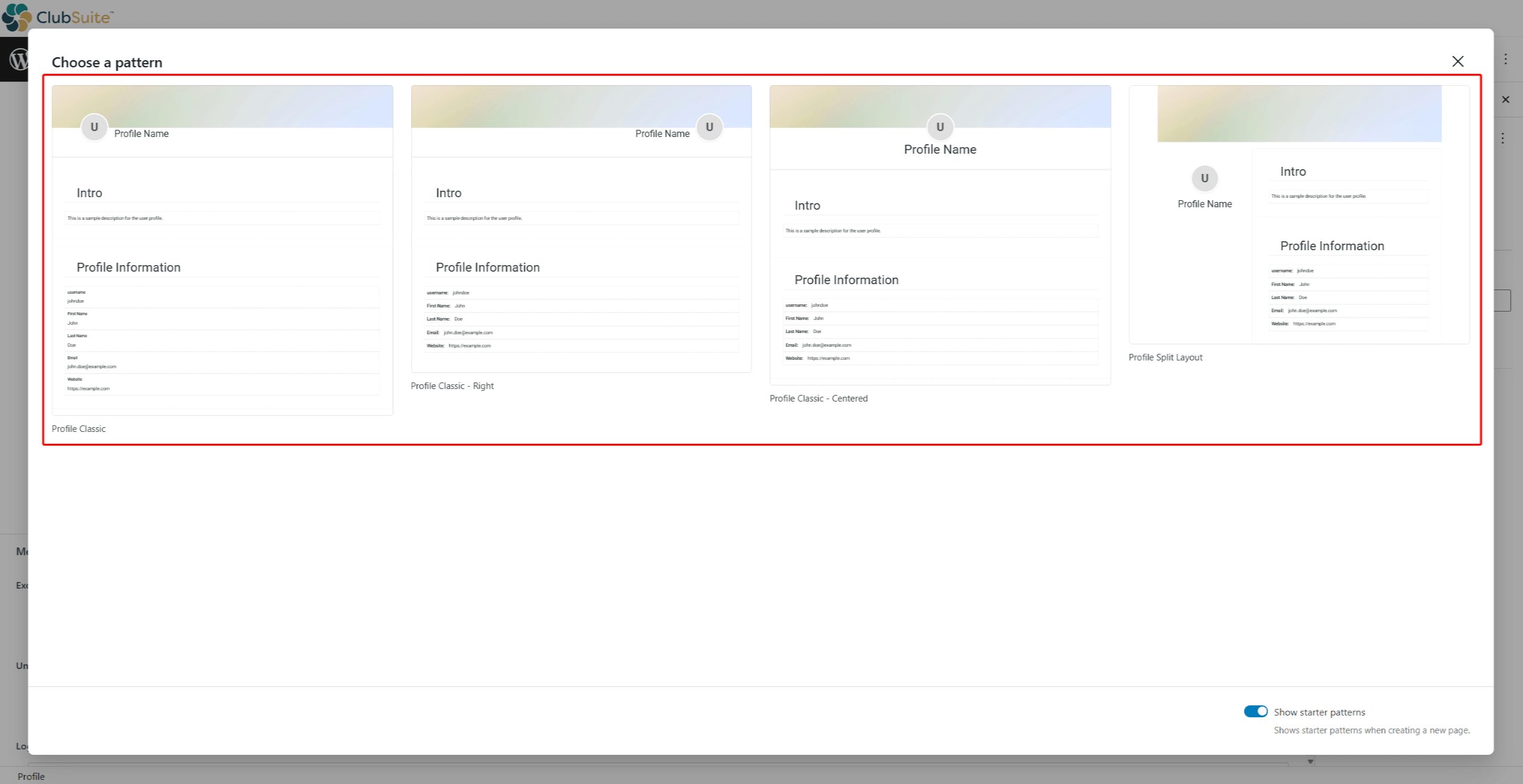
- Digite um título (name) that matches the use of the Profile you’re creating (e.g “Pro Member Profile”).
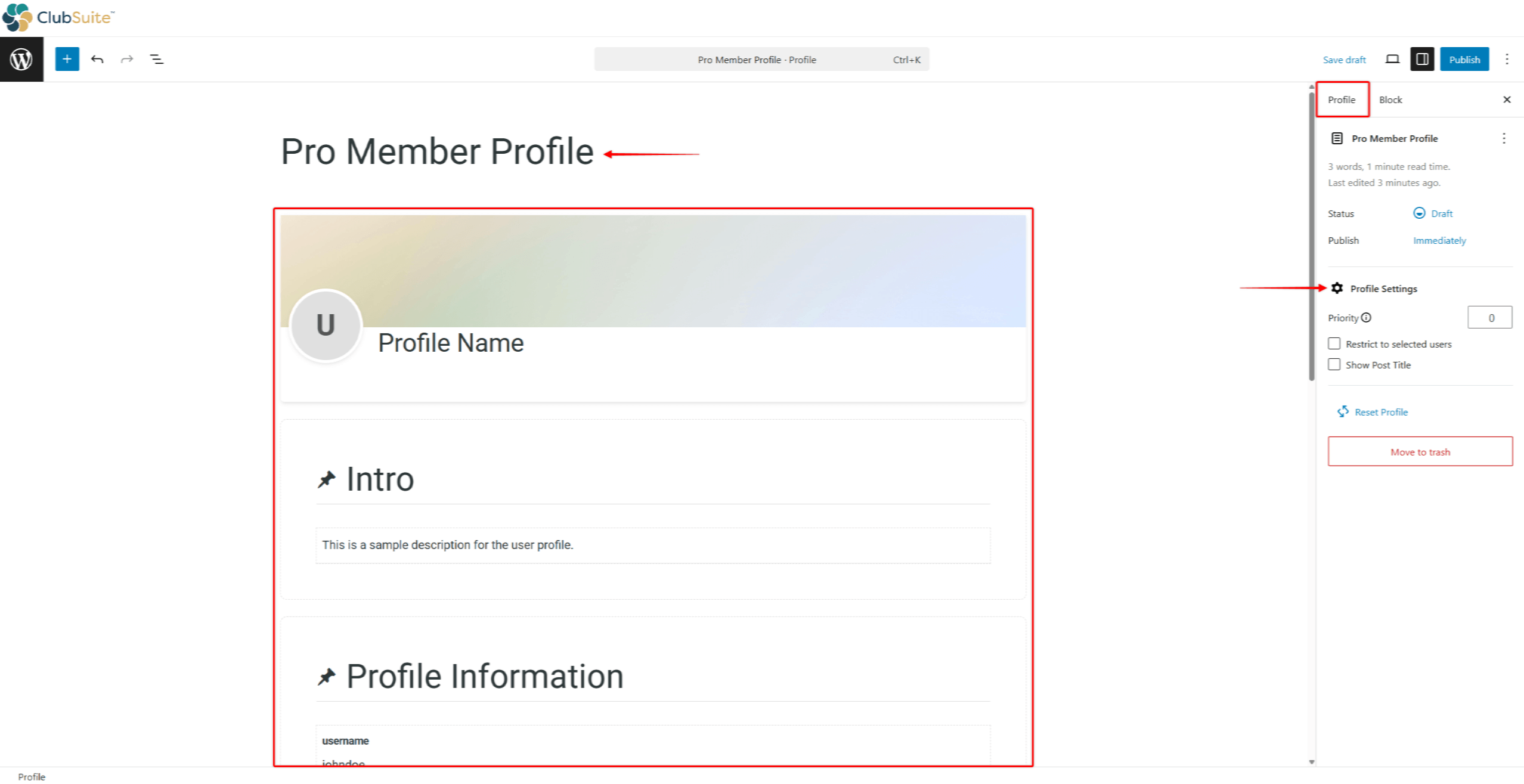
- Design the user Profile. You can use Profile blocks as well as any other Gutenberg block to design Profiles.
- In the right-side panel, configure the Profile Settings:
- Prioridade: Profiles use priorities when members match multiple Profiles. In this case, the system applies the Profile with the highest priority number, thereby preventing conflicts.
- Restrict to selected users: assign a profile to a specific group of users;
- Show Post Title: enabling this option will display the Profile title.
- Clique no botão Publicar button to save the profile.
You can create as many Profiles as needed.
Designing Member Profiles
You can design profiles using premade Starter Patterns or create your own custom design. MemberPress Profiles editor is Gutenberg-based. This means you can design your profiles with profile-specific blocks and any other Gutenberg block.
Designing Profiles should be based on your business model and relevant to the specifics of communities on your website. Furthermore, you should create designs that maintain a good balance between information density and visual appeal.
Position the more critical information so it stands out and can be easily noticed by users. Use larger fonts for primary details and group related content within sections.
Maintain consistency with uniform fonts, consistent spacing, thoughtful brand colors, and uniform photo sizes. Test profiles on various screens to ensure profiles work well on all devices.
Using Profile Starter Patterns
MemberPress includes four professional profile patterns as starting points:
- Profile Classic positions the member profile photo and name to the left side of the profile header. All other member information is aligned to the left;
- Profile Classic – Right mirror reflects the Classic pattern header, featuring a member profile photo and name. All other member information remains aligned to the left;
- Profile Classic – Centered aligns the member profile photo and name in the center, with all information aligned to the left;
- Profile Split Layout divides profiles into three distinct sections. The profile header is located at the top of the page, and the rest of the page is divided into two sections: left and right. Here, the member profile photo and name are located on the left. The remaining member information is located on the right.
When adding a new profile type, you will be prompted to choose one of the available Starter Patterns.
If skipped, you can add these patterns through the Block inserter:
- Navigate to the profile type, hover over its name, and click Editar.
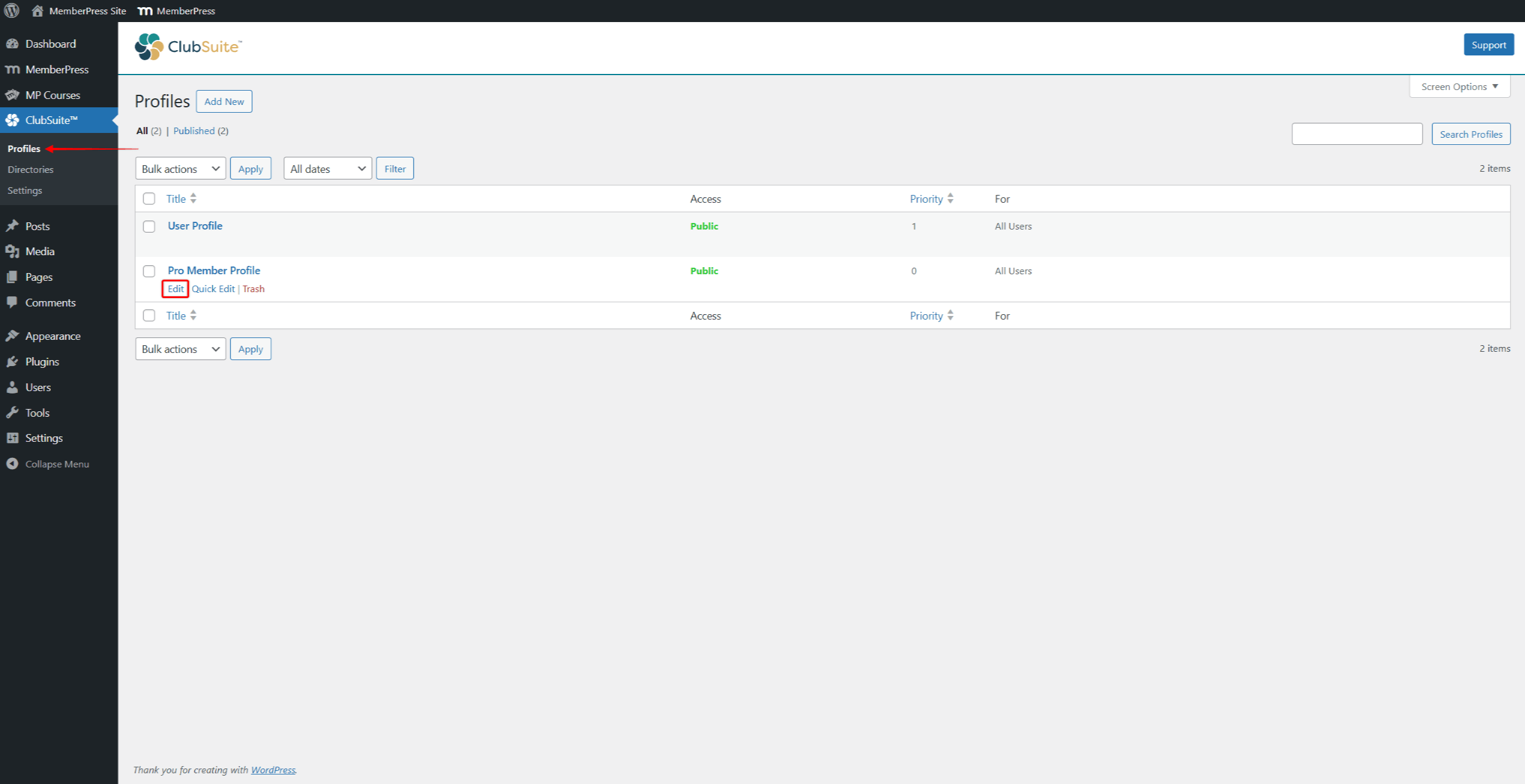
- Click the Block inserter + ícone.
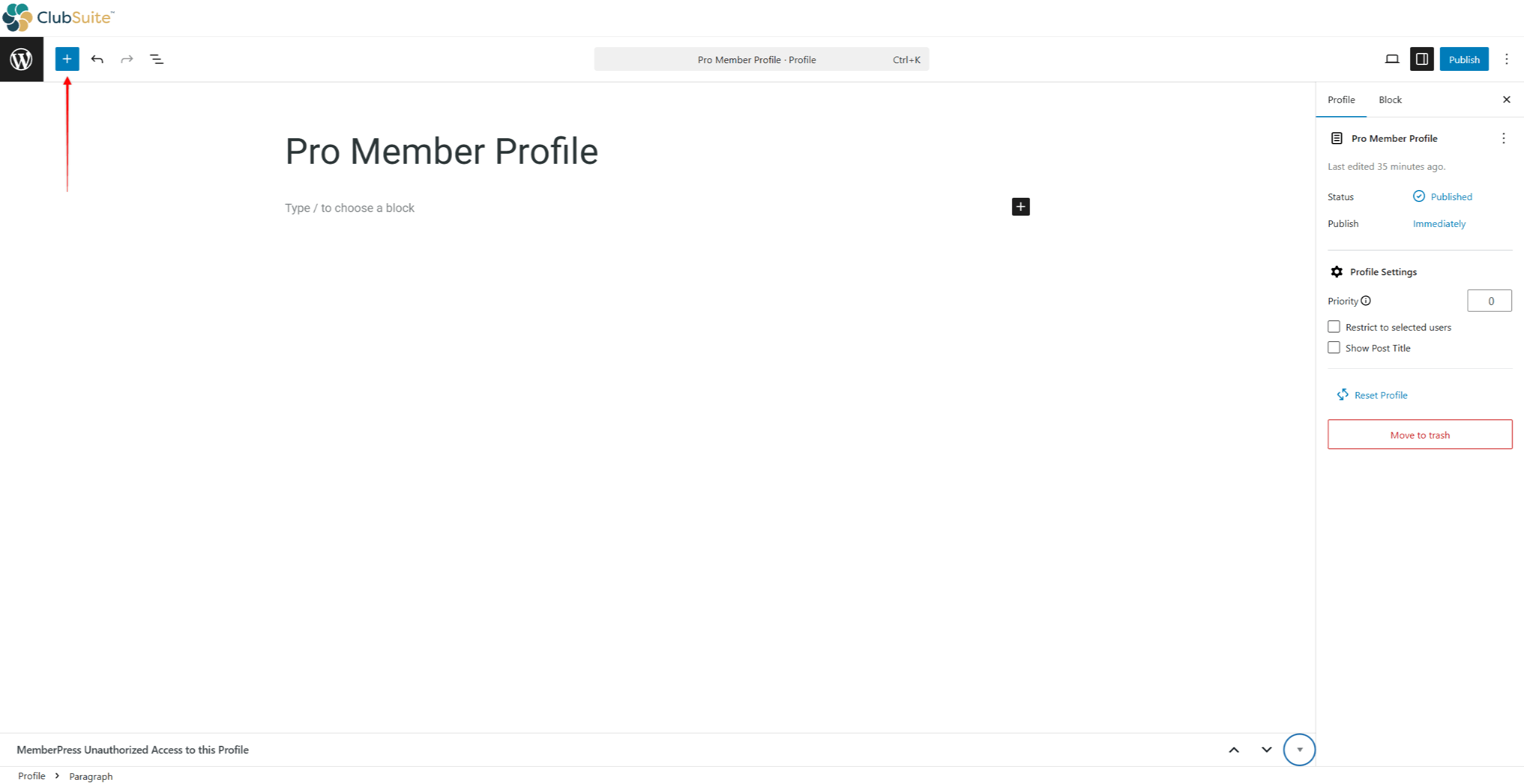
- Em seguida, clique no botão Patterns tab, and scroll down to the Strater Content grupo.
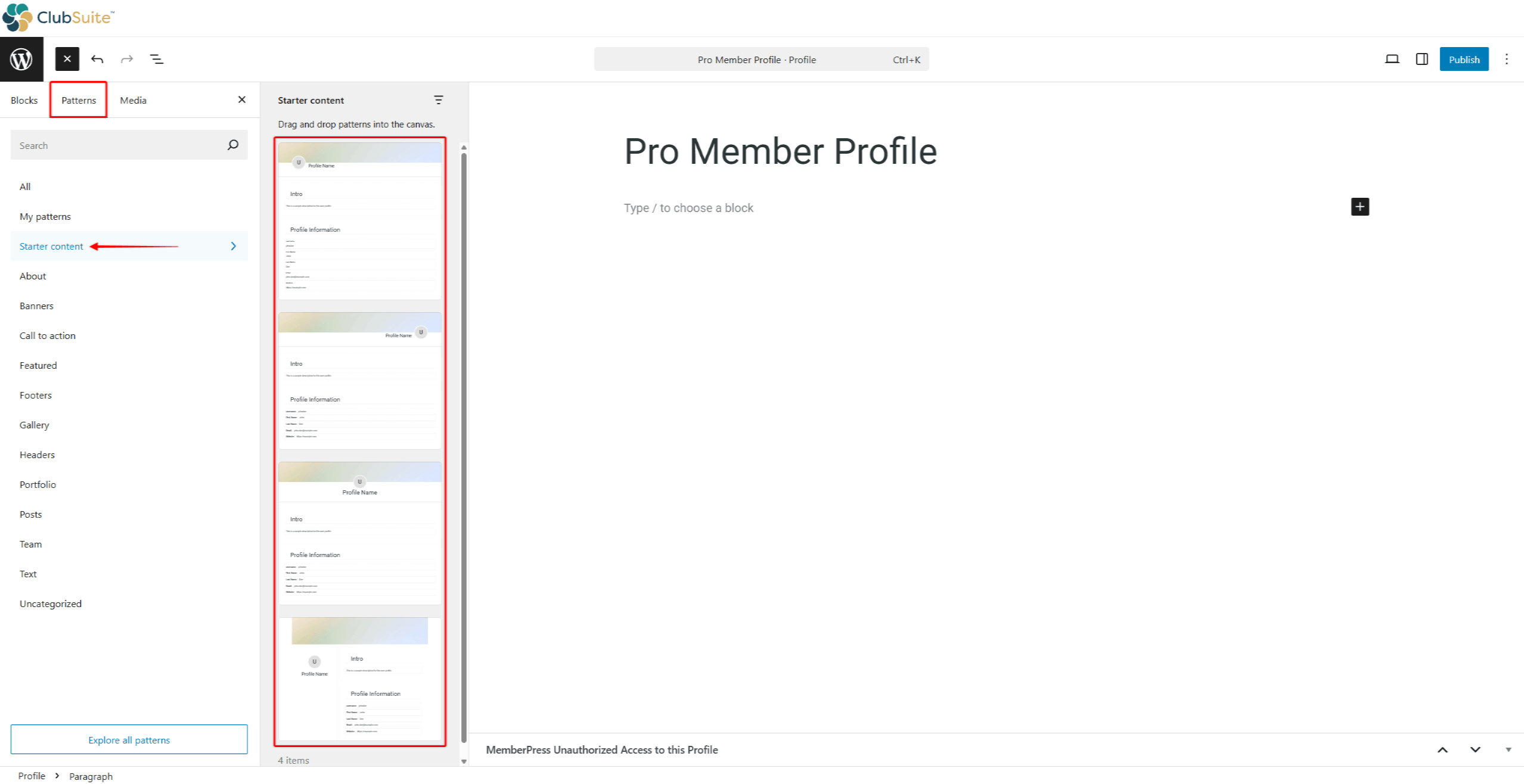
- Selecione your preferred pattern to add it to the Profile.
Patterns are groups of Profile blocks. You can add or remove Profile blocks, add any additional Gutneberg blocks, and customize each block to match your brand.
Working with Profile Blocks
The Profile blocks are individual components you can use to design your member profiles using the default (Gutenberg) editor.
Each MemberPress Profile block is used to display member-specific data on users’ Profile pages and comes with extensive customization options:
- O Profile Header Block spans over the full width of the profile card. Configure background colors, enable cover images, control height, and add overlays for text readability.
- Profile Section Blocks organize content into logical groupings. Add titles, customize backgrounds, control padding, and apply borders for visual separation.
- O Profile Photo Block displays member images with size controls, shape options (square, rounded, circular), border treatments, and fallback images for members without photos.
- Profile Cover Blocks show banner images, allowing personal expression. Set default covers, control dimensions, adjust positioning, and add overlays, ensuring content visibility.
- O Profile Name Block presents member identities with format options from first name only through formal full names, plus typography controls and supplementary text for titles.
- Profile User Fields Blocks display information from member profiles and custom fields. Select which fields appear, control labels, arrange in columns or lists, and handle empty fields intelligently.
- Profile Icons Blocks add social media links with platform selection, custom icons, consistent sizing, brand colors, and hover effects.
Assigning Profiles To Memberships
By default, Profiles are not restricted and are therefore set to be used for all members. But when using multiple profile types, you should assign each Profile to a specific user role or membership
Profiles are assigned to :
- Navigate to a Profile you wish to design, and start the Editor.
- On the right-side panel, click on the Profile tab.

- Role para baixo até Profile Settings e clique no botão Restrict to selected users caixa de seleção.
- Choose the restriction method:
- with the Role – users with specific WordPress user role (Subscriber, Author, Administrator, etc.);
- with a Membership – users with an active subscription to the particular MemberPress membership;
- with any Membership – users with an active subscription to any MemberPress membership;
- with no Membership – users with no active subscriptions.
- In case of with the Role restriction, also select the specific role. Similarly, for the with a Membership restriction, you need to select one of the memberships from the list.
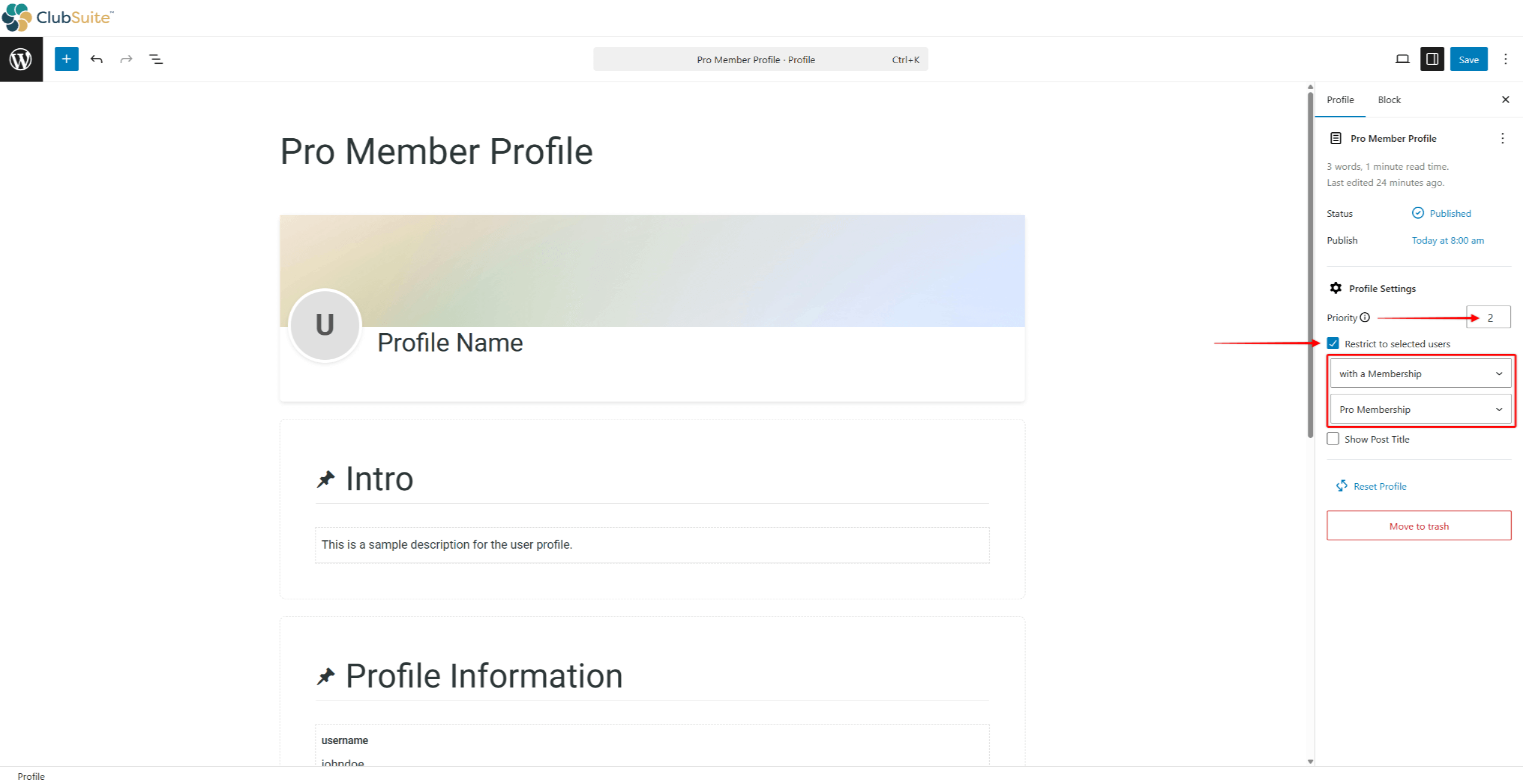
- Defina o Prioridade number for this Profile if you use multiple Profiles on your website.
Moderating Profile Content
To help members create compelling profiles, provide guidelines and implement strategic defaults, including placeholder text, default images, and example content.
When profile moderation is enabled, review uploads promptly while maintaining consistent standards and providing constructive feedback:
- Navegue até a seção Profile settings página (Dashboard > ClubSuite™ > Settings > Profiles tab).
- Under the Reserved Pages & Moderation section, toggle on the Require admin approval of profile and cover images opção.

- Clique em Opções de atualização.
Now, you’ll see a new Approve Uploads opção em Dashboard > ClubSuite™.
Managing the Approval Queue
Enabling moderation allows you to maintain quality standards and remove inappropriate content:
- Navegue até Dashboard > ClubSuite™ > Approve Uploads.
- Review pending uploads showing:
- Thumbnail preview
- Member name
- Upload timestamp
- Image type
- For each upload:
- Clique em Aprovar to publish the image;
- Clique em Reject to decline and notify the member;
- Clique em View Full Size to examine details.
Approved images appear immediately on profiles.




